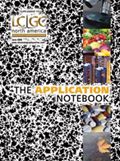Headspace Analysis of Volatile Organic Compounds (VOCs) in Contact Packaging Materials Using the HT3 Automated Headspace Analyzer
The Application Notebook
The United States Food and Drug Administration (U.S. FDA) and the European Union (EU) have published regulations and provided guidance on the use of chemicals in food packaging materials. Tekmar provides method parameters for the HT3â„¢ Automated Headspace Analyzer for the determination of VOCs that may be contained in food contact packaging materials under various conditions. Temperature and mixing parameters were investigated to determine which VOCs may be released when subjected to these conditions.
Teri Dattilio, Teledyne Tekmar
The United States Food and Drug Administration (U.S. FDA) and the European Union (EU) have published regulations and provided guidance on the use of chemicals in food packaging materials. Tekmar provides method parameters for the HT3™ Automated Headspace Analyzer for the determination of VOCs that may be contained in food contact packaging materials under various conditions. Temperature and mixing parameters were investigated to determine which VOCs may be released when subjected to these conditions.

Figure 1
A Thermo Fisher DSQ II MS and Focus™ GC and HT3™ Automated Headspace Analyzer run in the static mode were used for the analysis of several food contact packaging materials. Uniform samples (determined by size or weight) were added directly to a 22 mL headspace vial. This vial was then sealed and placed onto the autosampler for analysis. The HT3™ ran in the static mode while two parameters were varied, the Sample Platen Temperature (50–200 °C) and Sample Mixing (on or off). Sample mixing remained constant at Level 5 and was employed to assist in releasing possible VOCs from the solid materials
Data Collection and Discussion
Uniformity among sample aliquots were determined either by size or weight to maintain. Heating at various temperatures was investigated as most products require heating the contents prior to consumption. Literature indicates that 100 °C is used to mimic optimal heating as this is the boiling point of water (1). Sample Temperature ranges of 50–250 °C for all packaging materials were investigated. Analysis for samples below 100 °C indicated poor response while the higher more extreme temperatures caused the material to char, rendering the chromatographic results inconclusive, therefore as expected the optimum temperature of 100 °C was selected. Seven replicates were analyzed at 40 °C as a baseline to determine if any VOCs were emitted from the products prior to heating. Several blanks were run prior to each analysis batch to ensure system cleanliness. All five packaging materials produced their own unique chromatograms at the optimum temperature of 100 °C. An example of a microwaveable meal container is presented. Notable for the microwaveable meal container is the presence of long chain hydrocarbons; methyl heptane, trimethyl hexane, dimethyl heptene from 5.10–7.01 min. The majority of compounds present were; alcohols, ketones, and branched and straight chained hydrocarbons. The presence of 2-pentanone, also known as methyl propyl ketone, was found in four of the five packaging products investigated. 2- pentanone is sometimes used in very small amounts as a flavoring food additive. Two other ketones, 3-pentanone and methyl isopropyl ketone are isomers of 2-pentanone.
The HT3™ performed well in the static mode for analyzing solvents in food packaging materials. Chromatographically many of the identified peaks for all the contact packaging material analyzed were branched and unbranched hydrocarbons from C6 through C18. Additionally many alcohols, ketones, trace amounts of aromatics such as phenol and low-level VOCs such as 2-butanone and benzene were identified. The late eluting peaks between 10–13 min for the boil in the bag rice packaging (alkane hydrocarbons) were not seen in this order in any other packaging material investigated making this products identification unique (1). It should be noted that this technique is excellent for differentiating between contact packaging products as each displayed unique fingerprints. Static headspace analysis permits the analysis of the trace surface components making this unique distinction possible. The trapping module of the HT3™ was not utilized for this investigation. Further studies are underway using dynamic headspace analysis as it offers significantly lower levels of detection. Using the method parameters in this investigation the identification of VOC contaminants is possible through static headspace analysis. The Tekmar system allows for unattended operation and no sample preparation. The Method Optimization Mode (M.O.M) has many advantages as no sample preparation is needed. The HT3™ is capable of switching between both static and dynamic modes within a single schedule enabling both low and high level component analysis. The HT3™ allows laboratories the ability to fine tune for both quantitative and qualitative analysis of contact packaging materials.
Reference
(1) "Determination of Off-Odors and other Volatile Organics in Food Packaging Films by Direct Thermal Analysis-GC-MS," Thomas Hartman, The Mass Spec Source, Vol. XIII, No. 4, pg. 30 (Dec 1990).

Teledyne Tekmar
4736 Socialville Foster Road, Mason, OH 45040
tel. (800)874-2004, fax (513)229-7050
Website: www.teledynetekmar.com
















